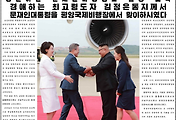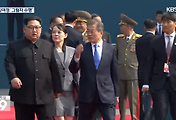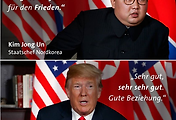Nakjung Kim
March 14, 2017 ·
The Guardian
·
[논평] 1. 미국 군수자본, 트럼프 앞세워 한국에 강압적 마케팅 전략이 바로 싸드 배치이다.
싸드 배치도 부족해서, 미사일 수송 가능한 '드론'을 한반도 상공에 띄울 예정이다.
한국 대통령 선거라는 정치적 축제를 앞두고, 미 군수자본 영업과장 트럼프가 한국에 무기 수출하러 오는 것이다. 정치 축제에 초치러 온다. 박사모 미성조기에 흥분한 트럼프가 미 성조기 아래로 무기 팔면 되겠다고 쾌재를 부르고 있다.
싸드 배치 계획과 미사일 수송 가능 드론 한반도 무력 시위, 이게 촛불광장 민심과 무슨 상관인가?
한반도 동북아 평화적 공존에 실효성도 없고 지속가능한 외교정책도 아니다.
2. 미 국무장관 렉스 틸러슨이 일본 한국 중국을 방문해, 미-일-한 삼각동맹을 확인하는 동시에 중국 시진핑에게 북한을 압박하라고 요청할 예정이다. 하지만 북한 정권교체를 위해서는 선제공격도 고려하고 있는 미국 트럼프 정권과 '평화'와 '안정'을 더 중시하는 중국의 동북아 외교노선은 서로 다르다.
따라서 이번 미 국무장관 틸러슨의 도쿄, 서울, 베이징 방문은 친미극우 박근혜 파면 이후 대선 국면에, 해이해진 한국 정치권에 무력시위를 한번 해주고, 동시에 미 군수자본의 상품들을 강매하려는 목적을 지니고 있다.
가디언 관련 기사 요약
1) 회색 독수리 드론은 무엇인가?
미국 '회색 독수리' 드론 휴전선 부근에 띄운다. 미사일 수송 가능 드론이다.
미국 휴전선 부근에 미사일 장착 드론 띄운다.
드론 이름은 ‘회색 독수리 Grey Eagle’ 이고 ‘지옥 화염 미사일 – 헬파이어 미사일’을 장착하고 있다.
2) 미국의 의도는 무엇인가?
한반도에서 미국이 군사적 근육을 한번 보여주겠다는 뜻이다.
북한이 일본을 향해 4개 미사일을 발사 실험한 지 1주일 이후에,드론 배치 발표는 미 국무장관 렉스 틸러슨(Rex Tillerson)이 세계 화약고 중에 하나인 동북아를 방문한다고 발표하기 하루 전에 전격적으로 이뤄졌다.
3) 프레데터 드론과 회색 독수리 드론 성능 차이는 무엇인가?
드론 기능은 정보 수집 감시 정찰이다.
회색 독수리 드론은 ‘포식자’라는 뜻의 프레데터 드론보다 성능이 뛰어나고 헬파이어 미사일을 실어나른다. 싸드 배치, 회색 독수리 드론 배치는 북한의 핵개발과 미사일 실험 발사에 대응하기 위한 것이다.
4) 현재 북한의 핵개발 수준은 어느 정도인가?
북한의 핵무기 기술 수준은 핵탄두를 적게 만들어 미사일에 장착할 수 있고, 대륙간 탄도(ICBM) 미사일을 미국 본토까지 날려보낼 수 있다.
마크 토너(Mark Toner) 미 국무부 대변인은 “싸드와 드론 배치는 북한 공격에 대비한 방어용이다”라고 발표했다.
5) 미사일 수송 '회색독수리' 드론 한반도 상공 배치 문제점은 무엇인가?
북한 핵무기 관련 전문가인 제프리 루이스(Jeffrey Lewis) 는 다음과 같이 경고했다. “만약 미국의 드론 이 한반도 상공에 미사일 배치를 뜻하는 건 아니라는 사실을 분명히 하지 않으면, 한반도에서 전쟁이 발발할 수 있다”
6) 제프리 루이스가 파악한 북한 입장은 다음과 같다.
(1) 북한은 자국의 정권 타도/교체(김정은 레이짐 체인지)를 예방하기 위해 핵무기를 사용할 것이다. 북한이 적대국 미국과 힘이 불균형하다는 것을 알고 있고, 미국이 북한을 선제공격할 것이라는 인지하고 있기 때문에 이러한 핵무기로 먼저 타격하는 것이다. 실제 전쟁이 발발하면 북한은 핵무기를 먼저 사용할 것이다.
(2) 미국과 한국의 선제 공격 계획
따라서 “미국은 북한이 핵무기를 사용하기 전에 먼저 북한의 핵무기를 파괴시킬 계획을 가지고 있다. 그리고 한국도 미국이 이런 타격 준비하기 앞서서 미리 북한의 핵무기를 공격할 계획이다”
7) 미 국무장관 렉스 틸러슨은 왜 동북아시아를 방문하는가?
주요 방문 목적은 북한의 지속적인 핵무기와 미사일 개발 때문에 이 지역 안보가 위협받고 있기 때문이라고 밝혔다.
(참고) 트럼프 행정부에 결합하기 전에 렉스 틸러슨은 석유회사 이사였다.
그가 수요일 일본 도쿄, 금요일에는 서울, 토요일에는 베이징을 방문해 시진핑과 회담할 예정이다.
(참고) 수잔 쏜튼(Susan Thornton) – 동아시아 태평양 국무 보좌관
8) 이번 트럼프 행정부 일본 한국 중국 방문은 실효성이 있을 것인가?
트럼프 정부는 중국이 북한에 더 많은 압력을 가해 핵무기 개발을 중지하도록 중국과 협상하려고 할 것이다.그러나 이러한 미국의 노력은 큰 성과를 기대하기는 힘들 것으로 많은 북한 전문가들은 예견하고 있다. 미국은 지난 20년 동안 북한의 핵개발을 막아내지 못했다.
중국과 미국이 북한 핵개발을 두고 어떠한 견해 차이가 있는가?
중국은 북한의 핵개발에 반대한다는 공식적인 입장이지만, 보다 중요한 것은 이 동북아 지역과 한반도에서 ‘평화’와 ‘(세력 균형) 안정’이고, 그 다음이 ‘비-핵화’이다. 이러한 중국의 기본입장은 현재도 변함이 없다.
트럼프는 북한에 대한 경제 제재 조치 이외에 직접적인 군사적 공격 또한 염두해두고 있다.
오바마 정권은 북한에 대해 사이버 전쟁을 실시해 어느정도 성과를 거뒀다.
미국내부에는 북한에 대한 강경론과 다른 시각도 존재한다. 미국이 북한에 대해 “예방적” 군사 행동을 취하면 취할수록, 오히려 북한은 미국 일본 한국에 더 강력한 보복 조치를 취할 것이다.
US to deploy missile-capable drones across border from North Korea
Deployment of Grey Eagle drones, designed to carry Hellfire missiles, in the South represents significant build-up of US military muscleJulian Borger in Washington
The US has declared it will permanently station missile-capable drones in South Korea in the latest round of military escalation in north-eastern Asia.
The drone deployment comes a week after North Korea carried out a test salvo of four missiles that landed off the coast of Japan, and a day before the US secretary of state, Rex Tillerson, embarks on a tour of a region widely regarded as the most dangerous corner of the world.
The US military in South Korea took the unusual step of publicly announcingthe deployment of a company of Grey Eagle drones, which it said would add “significant intelligence, surveillance and reconnaissance capability” for American and South Korean forces.
Grey Eagles, the army’s enhanced version of the Predator drone, are designed to carry Hellfire missiles and, together with the deployment of Thaad anti-ballistic missile defences in South Korea, they represent a significant build-up of US military muscle in response to an accelerated programme of missile and nuclear testing by the North Korean regime.
Pyongyang claims it has mastered the challenge of making a nuclear warhead small enough to put on the tip of a missile, and is working on an intercontinental ballistic missile (ICBM) capable of reaching the continental US.
“In addition to Thaad these [drones] are defensive measures that are a response to what we – and by ‘we’ I mean South Korea, the United States and Japan – view as a real and credible threat to our security,” said Mark Toner, the state department spokesman.
Jeffrey Lewis, an expert on the North Korean nuclear weapons programme, warned that unless the US military made it very clear that the new drones would not carry missiles in Korean skies, they could bring an already very dangerous situation closer to the brink of war.
“If they are not going to arm them, they need to say that. They need to make them absolutely clear,” said Lewis, the director of the east Asia nonproliferation programme at Middlebury Institute of International Affairs at Monterey in California.
“The thing the North Koreans are most afraid of is that we’re going to kill Kim Jong-un in a decapitating strike and … that will strengthen their incentives to make sure that low level commanders will have the ability to use nuclear weapons. It will make the North Koreans even more jumpy and have a way itchier trigger finger.”
Lewis believes the North Korean strategy is to use a nuclear first strike to deter an attack aimed at regime change, a posture which makes for a particularly unstable balance of forces, with the adversaries motivated to act preemptively.
“In a war they plan to use their weapons early,” Lewis said. “We plan to hit them before they do that, and the South Koreans plan to hit them before we have a chance to take too long to do that.”
The threat represented by North Korea’s growing nuclear and missile arsenal is the principal reason for Tillerson’s trip to the region. The former oil executive, who has so far been a muted presence as secretary of state, arrives in Tokyo on Wednesday, moves on Friday to Seoul, which is in the grip of a political crisis, and then travels the next day to Beijing to hold talks with President Xi Jinping and other officials.
“The idea is this trip will allow secretary Tillerson to engage allies and partners, not only on a range of bilateral issues, but also importantly to discuss and coordinate strategy to address the advancing nuclear missile threat from North Korea,” said Susan Thornton, the acting assistant secretary of state for east Asian and Pacific affairs.
Tillerson is taking on a looming problem that has defeated Washington’s best diplomatic efforts for more than two decades. The US and its allies insist that North Korea freeze its nuclear weapons development, but Kim Jong-un – who took over leadership after the death of his father Kim Jong-il in 2011 – has shown himself determined to develop a significant nuclear arsenal.
He has tested missiles capable of reaching South Korea, Japan and US forces based there, and has plans to test an ICBM that could hit the US west coast, something Donald Trump declared in early January “won’t happen”. But it is unclear how the new president would enforce this.
“I believe Tillerson wants to achieve a greater unity of the US allies in front of the North Korean nuclear programme which is advancing faster than anybody has ever expected,” said Andrei Lankov, professor of Korean studies at Kookmin University in Seoul. “In Seoul and Tokyo he wants to gain support for more pressure, and perhaps he even hopes to get something from the Chinese, to persuade them that pressing North Korea hard is in China’s long-term interests.
“However, these efforts are not going to bear any significant results: sanctions do not have any noticeable impact on North Korea.”
Trump has suggested that Beijing could constrain Kim, but most experts on the region say it has limited sway over the regime in Pyongyang as the Chinese leadership is fearful of triggering a total collapse of its neighbour.
“China wants the denuclearisation of the north but its priorities continue to be different from ours,” Sue Mi Terry, a former deputy national intelligence officer for east Asia in the US National Intelligence Council, told a Council on Foreign Relations event. “Their priorities are no war, no instability, no nukes, in a descending order meaning they seek peace and stability and then denuclearisation – and that has not fundamentally shifted.”
Given the failure of sanctions, the Trump administration is reviewing other methods, including possible military options. The New York Times reported earlier this month that the Obama administration had tried cyber warfare to sabotage Korean missiles. That effort appears to have had some successes but last week’s missiles tests suggest it is not a lasting solution in the face of Pyongyang’s determination.
Mary Beth Long, an assistant secretary of defence in the Bush administration, said the US should consider carrying out air strikes to stop missile tests.
“China has made the decision to support North Korea,” Long said. “We can see if China is willing to change that, but we can’t have US policy held hostage to Chinese long-term and short-term decisions regarding North Korea.”
Others voices in Washington argue that any such “preventative” military action is likely to trigger heavy North Korean retaliation against US allies and forces in the region.
'한국정치 > 북한_DPRK' 카테고리의 다른 글
| 제 3차 남북 정상회담에 대한 도널드 트럼프 반응 (0) | 2018.09.19 |
|---|---|
| 북한 노동신문 (로동신문)이 보도한 문재인 김정은 제 3차 정상회담 (0) | 2018.09.19 |
| Trump 김정은에게 감사 표시 l look forward to seeing you soon! (0) | 2018.08.02 |
| 로동신문 김춘순, 문재인 정부 한반도운전자론 비난 해석과 대응 방향 (0) | 2018.07.21 |
| 북미회담 트럼프 기자회견 주제별 요약 - CVID 대신 완전한 비핵화 단어 쓰다 (0) | 2018.06.12 |
| Trump becomes first U.S. president to meet a North Korean head of state; 'major change' coming (0) | 2018.06.12 |
| 북미회담 김정은 트럼프 공동합의문 서명, 김정은 "과거를 묻고, 새 출발하는 문건에 서명한다" (0) | 2018.06.12 |




